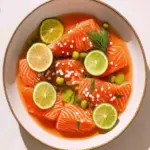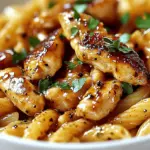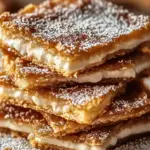Shrimp Rangoon is a beloved Asian-inspired appetizer that combines the irresistible textures of crunchy fried wontons and creamy, savory filling. The mixture of chopped shrimp, cream cheese, and aromatics creates a perfectly balanced flavor profile that satisfies with each bite. Often served in Chinese-American cuisine, this dish brings a restaurant-quality experience straight to your kitchen with very little effort. These Shrimp Rangoons are ideal for entertaining guests or simply treating yourself to something indulgent. The crispy wrapper gives way to a luscious shrimp and cheese center that pairs beautifully with dipping sauces like sweet chili or soy. They’re perfect as a make-ahead appetizer and can even be air-fried for a healthier twist. Whether you’re hosting a party, prepping for a holiday meal, or wanting a fun dinner addition, these rangoons deliver every time.
Full Recipe:
Ingredients:
-
1 cup cooked shrimp, finely chopped
-
4 oz cream cheese, softened
-
2 green onions, finely sliced
-
1 tsp garlic powder
-
1 tsp soy sauce
-
1/2 tsp sesame oil
-
24 wonton wrappers
-
Oil for frying
-
Sweet chili sauce or soy sauce for dipping
Directions:
-
In a bowl, combine chopped shrimp, cream cheese, green onions, garlic powder, soy sauce, and sesame oil until fully mixed.
-
Lay out the wonton wrappers on a clean surface. Place about 1 teaspoon of the shrimp mixture into the center of each wrapper.
-
Moisten the edges of the wrapper with water, then fold into a triangle or pinch into a rangoon shape to seal tightly.
-
Heat oil in a deep skillet or pan over medium-high heat.
-
Carefully fry the filled wontons in batches, turning occasionally, until golden brown and crispy (about 2–3 minutes).
-
Remove and drain on paper towels.
-
Serve hot with your preferred dipping sauce.
Prep Time: 15 minutes | Cooking Time: 10 minutes | Total Time: 25 minutes
Kcal: 130 kcal per rangoon | Servings: 24 pieces
The Irresistible Appeal of Shrimp Rangoon: A Fusion of Crispy, Creamy Perfection
Shrimp Rangoon is one of those timeless appetizers that blends simplicity with luxurious flavor. Featuring a rich, creamy filling made with cream cheese and succulent shrimp, all wrapped in delicate wonton wrappers and fried to golden perfection, this dish offers a delightful contrast of textures and flavors. It’s no surprise that Shrimp Rangoon has become a staple at Asian-inspired restaurants and homemade party platters alike. In this article, we explore the history, cultural significance, versatility, and serving suggestions of Shrimp Rangoon, as well as the reasons it continues to captivate both casual food lovers and seasoned home cooks.
A Brief History and Cultural Background
Shrimp Rangoon is a creative variation of Crab Rangoon, a dish that’s believed to have originated not from Asia but from mid-20th-century American Chinese restaurants, particularly Trader Vic’s in San Francisco. While crab is the more traditional filling, shrimp has become a popular substitute or alternative, thanks to its sweet, firm texture and wide availability.
Despite its name, “Rangoon” references the capital of Myanmar (now Yangon), yet the dish itself does not stem from Burmese cuisine. Instead, it’s a product of the fusion food movement an example of American interpretations of Asian flavors. Shrimp Rangoon falls into a category often referred to as “Chinese-American cuisine,” which has its own distinct characteristics separate from authentic regional Chinese dishes.
Why Shrimp Works So Well
Shrimp is an excellent protein choice for this appetizer. Its natural sweetness complements the tangy cream cheese and umami-packed seasoning elements like soy sauce, garlic, and green onions. Additionally, shrimp cooks quickly, maintains its texture well when chopped and mixed, and doesn’t overpower the dish.
Compared to crab, shrimp offers a more accessible and often more affordable option for home cooks, especially those who may not have access to high-quality crab meat. Shrimp is also versatile enough to work in both fried and baked versions of the recipe, offering plenty of culinary flexibility.
Texture, Flavor, and Sensory Appeal
One of the key reasons Shrimp Rangoon is so beloved is its perfect balance of textures and flavors. When done right, the outer wonton shell turns a light golden brown with a satisfying crunch. This crispiness gives way to a creamy, savory filling that’s rich but not overwhelming. The flavor profile typically includes garlic, green onions, and sometimes a splash of soy sauce or sesame oil, providing a gentle kick of umami and aromatics.
The mouthfeel is another standout aspect light, crispy edges with a smooth, velvety center. This contrast creates a unique sensory experience that keeps people coming back for more. Served hot with a sweet chili dipping sauce or soy-based blend, Shrimp Rangoon becomes an irresistible finger food that vanishes quickly at gatherings.
Versatility for Every Occasion
Shrimp Rangoon isn’t just for fancy restaurant menus it’s incredibly easy to prepare at home and fits a wide variety of occasions. Whether you’re serving it as a pre-dinner snack at a dinner party, adding it to a holiday appetizer spread, or preparing a simple weeknight indulgence, this dish works seamlessly. It’s also a crowd-pleaser among all age groups, from kids who love the crunchy exterior to adults who appreciate the flavor depth.
You can tailor the recipe to fit dietary needs or preferences. Swap the traditional frying method with baking or air frying for a lighter version. Add spicy elements like sriracha or chili flakes to the filling for heat. For a gluten-free version, use rice paper wrappers or gluten-free wonton skins if available.
In terms of presentation, Shrimp Rangoon can be styled in multiple shapes triangles, money pouches, or flower-petal folds. This allows you to customize the aesthetic appeal depending on your theme or occasion.
Dipping Sauces and Pairings
No Shrimp Rangoon experience is complete without a flavorful dipping sauce. Sweet chili sauce is a classic and provides a lovely balance of sweet and spicy. Soy sauce or tamari with a hint of rice vinegar and a touch of honey makes for a delicious umami dip. If you prefer something creamy, a wasabi-mayo blend or a ginger-infused aioli can offer an elevated twist.
Pairing options extend beyond just sauces. Serve Shrimp Rangoon with a light cucumber salad, pickled veggies, or even as part of a dim sum-inspired spread that includes dumplings, spring rolls, and steamed buns. For beverages, pair with chilled white wines like Riesling or Sauvignon Blanc, which balance the richness of the cheese and the saltiness of the seafood.
Tips for Making It at Home
While the concept of Shrimp Rangoon is simple, a few techniques can ensure success every time:
-
Use softened cream cheese: This helps you mix the filling evenly and achieve a smooth, cohesive texture.
-
Avoid overfilling the wrappers: Too much filling can cause the wontons to burst during cooking.
-
Seal tightly: Use water to moisten the wrapper edges and press firmly to prevent leaks.
-
Don’t overcrowd when frying: Give each piece enough room in the oil to cook evenly and stay crispy.
-
Serve immediately: These are best enjoyed hot and fresh for maximum crunch and flavor.
Storage and Reheating
While Shrimp Rangoons are best eaten fresh, they can be stored in the fridge for up to two days or frozen for later use. To reheat, avoid the microwave, which can make them soggy. Instead, use an oven, toaster oven, or air fryer to restore crispness. If you’re planning a party, you can prepare them in advance and freeze them uncooked just fry straight from frozen, adding an extra minute or two of cooking time.
Health and Nutritional Considerations
Each Shrimp Rangoon contains approximately 120–140 calories, depending on the size and cooking method. While fried versions are more indulgent, using an air fryer or baking method can significantly reduce fat content. Shrimp itself is a low-calorie protein, and when paired with cream cheese, provides a satisfying richness in smaller portions. This makes Shrimp Rangoon a good choice for an appetizer that feels decadent without being overly heavy.
If you’re trying to cut back on dairy, lactose-free cream cheese alternatives can work. For those avoiding shellfish, finely chopped cooked chicken or mushrooms can be substituted to maintain texture and moisture.
A Dish That Stands the Test of Time
Shrimp Rangoon is more than just an appetizer it’s a conversation starter, a comfort food, and a culinary crossover success. Its roots in Chinese-American cuisine demonstrate how cultural fusion can lead to delicious innovations. Its adaptability to various cooking methods, flavor profiles, and dietary preferences ensures that it remains relevant in kitchens everywhere.
Conclusion:
Shrimp Rangoon continues to shine as a standout appetizer for a reason. It’s visually appealing, packed with flavor, and surprisingly simple to make. Whether you’re crafting a themed dinner, preparing snacks for a movie night, or impressing guests at your next gathering, this dish is guaranteed to please. Its versatility means you can adjust it to suit any crowd or occasion, and the balance of creamy, crispy, and savory is simply unforgettable.






